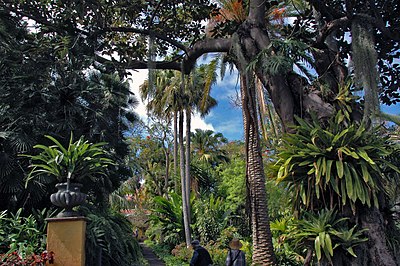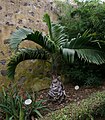La Orotava aclimatación garden
The Jardín de aclimatación de La Orotava , also Jardín Botánico de la Orotava , often simply called Botánico , also Latinized in botanical scripts Hortus aclimatationis plantarum arautapae , is a botanical garden in Puerto de la Cruz (the old port of La Orotava ) on Tenerife .
history
Originally the "Jardín de aclimatación" was ordered by the enlightened-absolutist King Charles III. laid out by Spain on August 17, 1788 to accustom the exotic plants collected by its plant hunters in the Spanish colonies of the New World to the climate in the royal gardens of Madrid and Aranjuez .
The Jardín de aclimatación is named after the Royal Botanical Garden of Madrid , which was also designed by Charles III. was initiated, the second oldest botanical garden in Spain.
The project was inspired, the ideal location was selected after extensive germination tests, and the garden was initially managed by Alonso de Nava y Grimón , VI. Marqués Villanueva del Prado (1757-1832). The site itself was a gift from Don Francisco Bautista de Lugo y Saavedra, Señor de Fuerteventura.
Although Charles III died. 1788, a few months after his command, but his successor Charles IV was also in favor of the project. In 1790, work began on the system, which was strictly geometrically shaped according to plans by the architect Diego Nicholas Eduardo . The work was completed in 1791. In 1792 the first 35 plantings and seeds were carried out.
The acclimatization indeed succeeded in Tenerife, but not on the mainland, because the climate in the interior of Spain due to frosts occurring not all plants provided a livelihood to the same degree.
The French naturalists Anselme Riedlé and especially Andre Pierre Ledrú (1761-1825) explored the island in 1796 after Nicolas Baudin's expedition was shipwrecked there. Ledrú prepared the first list of plants and suggested arranging the plants according to the system introduced by Linnaeus in 1753. Today, however, the plants are no longer arranged according to scientific criteria.
On June 20, 1799, the natural scientist Alexander von Humboldt visited the garden on his Tenerife expedition to climb Mount Teide . Many other naturalists, such as Aimé Bonpland , Pierre Marie Auguste Broussonet or Sabin Berthelot , also explored the famous garden.
After the death of Alonso de Nava y Grimón in 1832, responsibilities for the garden changed frequently, the garden remained in place, but fell into disrepair.
Hermann Wildpret era
From 1860 to 1893 the Swiss Hermann Wildpret (often wrongly called “Professore German Wildpret” on Tenerife) took over the position of head gardener in the “Botánico”. Under his leadership, the garden experienced a turning point: the variety of plants was greatly expanded. At the beginning of his activity 220 species were present, in 1879 already 2486 species. Under Wildpret, who also researched the endemic flora of Tenerife, as well as breeding varieties and a lively plant trade to and from Europe, the "Botánico" achieved world renown. Apart from the Pico del Teide , nothing in Tenerife has been described as often and in such detail in contemporary travelogues as the "Botánico".
After the Wildpret era, the garden fell into disrepair due to a lack of maintenance and horticultural expertise.
The French surrealist poet André Breton was inspired to write one of his poems by the garden in the 1930s.
Sventenius era
In 1943 the Swedish botanist Sventenius visited the garden. He then spent more than 20 years scientifically researching his plant population as a director, initially even planning an expansion and already acquired a plot of land for it. The project failed, however, and he then created a botanical garden on Gran Canaria , the "Jardín Canario", also called " Jardín Botánico Canario Viera y Clavijo ".
Current situation and future planning
The garden has been the Department of Agricultural Research and Technology of the Ministry of Agriculture and Food of the Government of the Autonomous Community of the Canary Islands since 1983.
More recently, efforts have been made to renovate and beautify the "Botánico". In 1988 work began on enlarging the garden by a further 35,000 m² to 55,000 m² and completing it with further attractions and all the structural facilities of an internationally important botanical garden, especially for educational purposes. An originally existing plant greenhouse has been demolished, but new ones are to be built.
However, the main undisputed drawback that has accompanied the garden almost continuously since its creation still exists today: the frequently changing responsibilities and the lack of permanent management.
meaning
Nevertheless, the "Botánico" is still considered one of the most beautiful botanical gardens and is one of the most visited attractions in Tenerife. It is visited by almost 400,000 visitors every year.
The specialty of the "Botánico" is that the most diverse plants from Europe, Africa and America can grow here next to each other thanks to the special climatic and orographic conditions. Over 5,000 plant species, 120 tree species and a collection of over 50,000 plants from five continents can be found on an area of 60,000 m². Palms, Bromeliaceae, Araceae and Moraceae, many species of the flora of Macaronesia and individual old plants that may still come from the early days (araucarias, Canary pines) are predominant . Also be in guidebooks often touted strangler fig , the Sausage tree or pokeweed .
Today's botanical garden takes part in the international exchange of plant material and various research and species protection programs and maintains a herbarium with almost 40,000 documents (the basis of which was the herbarium laid out by Erich Sventenius ).
A branch of the Botanical Garden is the “Hijuela del Botánico” in La Orotava , 3,390 m² in size, with old dragon trees , strelitzia , lilies, banana trees and other subtropical plants.
photos
See also
Sources and literature
Plant and seed catalogs
- Ministerio de Fomento. Dirección General de Agricultura y Montes: Catálogo de las plantas existentes en el jardín de aclimatación de La Orotava (Canarias): July 1923 ; Madrid: Hernández, 1923
- Instituto Nacional de Investigaciones Agronomicas: Catálogo de las plantas existentes en el Jardín de Aclimatación de la Orotava ; Puerto de la Cruz: Instituto Nacional de Investigaciones Agronomicas, 1968
- Index Seminum , 2003 (doc format)
Historical documents and descriptions
- Bolleter, Eugen: Pictures and studies from a trip to the Canary Islands . Leipzig: P. Papst, 1910; Chapter 5: Hermann Wildpret, the creator of fame from the botanical garden in Orotava, online text here
leader
- Faustino Castilla: El jardin botánico de la Orotava (Spanish); Madrid [u. a.]: Ed. Everest, 1984, ISBN 84-241-4466-X
- Andrés García Cabezon: Orotava Botanical Garden. Descriptive Guide (German), 5th edition, Tenerife: Romero, 1969
- Vicente Rodríguez García: El jardín botánico de Tenerife: esquema de su historia ; Las Palmas de Gran Canaria: Mancomunidad de Cabildos, 1980
Web links
- Jardín de aclimatación (Orotava Botanical Garden) (Spanish, many historical images)
- History and current development (Spanish)
Coordinates: 28 ° 24 ′ 41 ″ N , 16 ° 32 ′ 9 ″ W.













